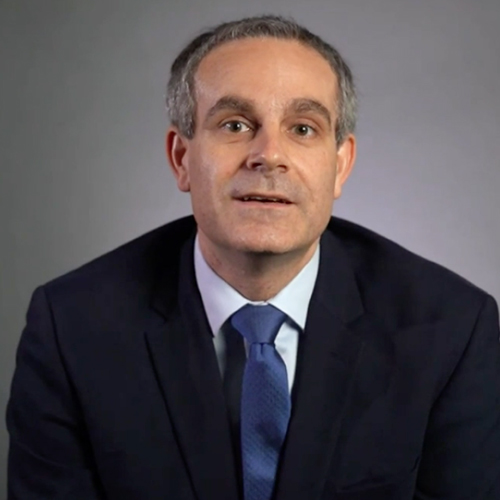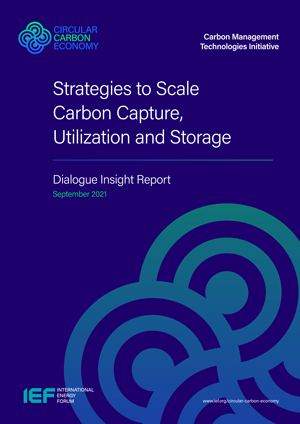Strategies to Scale Carbon Capture, Utilization, and Storage
6th IEF-KAPSARC Thought Leaders' Roundtable and 1st High-Level Roundtable on Carbon Management Technologies
In collaboration with the
Clean Energy Ministerial
Monday 27 September 2021, Virtual Event
Introduction
The First High-Level Roundtable on Carbon Management Technologies focused on what works and what needs fixing to deploy large-scale Carbon Capture, Utilization and Storage (CCUS) projects from government, industry, and the finance community perspectives. In response to Ministers' calls to accelerate the Circular Carbon Economy, including CCUS and other carbon management technologies, the roundtable reviewed CCUS strategies in different economic contexts, focusing firstly on the Gulf Region. The meeting discussed the uptake of CCUS technologies in the Gulf and also brought experiences in industrial clusters in North-West Europe, North America, and Asia-Oceania, to inform discussions on comprehensive CCUS strategies.
Despite the progress made in certain areas over the past decades, a multitude of industry scale CCUS projects will have to enter operation to permanently store or use carbon dioxide, facilitate the launch of new energy carriers such as hydrogen and reduce the carbon dioxide emissions that renewables and nuclear power cannot displace. CCUS projects should therefore benefit from far greater government support to accelerate economy wide deployment. Beyond more comprehensive CCUS strategies that offer investors the certainty they require and governments the assurances that policy goals will be met reliably at acceptable cost, an international CCUS mechanism set up in collaboration with governments, market stakeholders, and international organizations can help to broaden the scope of CCUS policies and help catalyze investment.
This will enhance access to sustainable finance for industry, strengthen physical financial market stability, and broaden public acceptance and support for energy transition and climate change goals in both producer and consumer countries. Reducing real and perceived hurdles to CCUS by formulating comprehensive strategies has never been more important for a swift, secure, and sustainable recovery that meets affordable energy access and climate goals.
Guest Speakers
-

H.E. Shaikh Mohammed bin Khalifa Al Khalifa
Minister of Oil, Bahrain -

H.E. Suhail Mohamed Al Mazrouei
Minister of Energy and Infrastructure, United Arab Emirates -

H.E. Lars Andreas Lunde
Deputy Minister, Ministry of Petroleum and Energy, Norway -

H.E. David Turk
Deputy Secretary, Department of Energy, United States of America -

Alex Milward
Director for CCUS, Department for Business, Energy and Industrial Strategy, United Kingdom -

Joseph McMonigle
Secretary General, IEF -

Adam Sieminski
Senior Advisor to the KAPSARC Board of Trustees -

Dan Dorner
Head, Clean Energy Ministerial Secretariat (CEM) -

Jarad Daniels
Director, Office of Strategic Planning and Global Engagement, US DOE -

Ed Graham
Vice President, Low Carbon Solutions, ExxonMobil -

Christyan Malek
Managing Director, Head of Oil & Gas EMEA, J.P. Morgan -

Lee Beck
International Director for Carbon Capture, Clean Air Task Force (CATF) -

Tim Bertels
Senior Partner, Darel Group -

Syrie Crouch
Vice President, Carbon Capture Storage, Shell -

Julio Friedmann
Senior Research Scholar, SIPA Center on Global Energy Policy, Columbia University -

Tidjani Niass
Senior Sustainability Strategist, Saudi Aramco
Backgrounds
G20 Energy Ministers endorsed the Circular Carbon Economy Platform in September 2020. Major energy producing countries announced the establishment of the Net-Zero Producers Platform in April, the G7 Climate and Environment Ministers called to rapidly scale technologies and policies to decarbonize power systems by 2030 in May 2021, and the G20 Climate and Energy Ministers Meeting in Napoli on 23 July explicitly recognized the need for investment and financing for advanced clean technologies including CCUS and carbon recycling. Meeting shortly in advance of the UN Climate Conference (COP26) in November this year and the 17th Ministerial Meeting of the IEF devoted to "Orderly Transitions in A New Era: Energy Security and Shared Goals Post COVID-19" this high-level thought leaders meeting will accelerate the uptake of CCUS and circular carbon models in energy and climate policy, and industry practice.
IEF Dialogue Insights Report
The IEF Dialogue Insights Report launches IEF work on Carbon Management Technologies in respect of Carbon Capture, Utilization, and Storage in accordance with the guidance obtained from IEF and G20 Energy and Climate Ministers reflected in the IEF Program of Work 2020-2021, and benefits from a voluntary contribution from the Department of Energy of the United States.
 Download the full report PDF
Download the full report PDF It's Time to Green Light CCUS
The growth of renewables and electrification is crucial to achieving both climate and sustainability goals, but greater effort is required to bring other available solutions to market and explore new opportunities. The share of hydrocarbons in total primary energy demand is expected to range between 72 percent and 74 percent in 2040 according to main scenarios. This could fall to around 55 percent to meet both universal energy access and climate goals according to the IEA's and OPEC's alternative scenarios. The world economy will continue to rely on hydrocarbons under any scenario as the annual comparative analysis of outlooks shows. This means that clean energy technology deployment must reach scale at warp speed to achieve shared goals over the next decades. If evolving market trends are to match the growing level of ambition to achieve climate goals without losing sight of energy market stability and affordability, carbon management technology deployment by the hydrocarbon sector and energy intensive industries should benefit from far greater support.
Carbon management solutions such as CCUS, whether by design or market failure, still constitute the weakest link in new energy and climate policies. Comprehensive and robust carbon management strategies must deliver a growing share of emission reductions and will depend on successful solutions as scenarios show. Greater engagement between government, industry, the public and local communities will help to broaden support and accelerate CCUS deployment to ensure swift, affordable, and inclusive transitions towards climate neutrality by mid-century.
Carbon management can take two forms. The first includes nature-based solutions such as afforestation. The second includes engineered solutions that focus on clean energy technologies that capture, and permanently store, and/or use carbon dioxide (CO2) emissions to optimize biological and industry processes. Engineered solutions aim to control anthropogenic releases of CO2 emissions through technologies such as Carbon, Capture, Use and Storage or CCUS. The process involves capturing CO2 emissions from hydrocarbon production, coal, and natural gas power plants, and from heavy industry such as steel and cement manufacturing. Most CCUS facilities globally are tied to natural gas processing and made economically viable through enhanced oil recovery (EOR). Carbon capture processes can also be combined with Direct Air Capture (DACCS) and Bio Energy (BECCS) to provide a more comprehensive solution in achieving net-zero ambitions.
CCUS deployment can be accelerated in industry clusters by pooling CO2 streams for energy generation, waste management and product manufacturing. Notwithstanding market hurdles and public acceptance issues, key international organizations cite the importance of CCUS as a critical solution to emissions reduction and achieving net-zero climate strategies.2 Furthermore, CCUS is not an isolated function that captures, stores, and reuses carbon in a single value chain or biological cycle. Instead it offers holistic solutions necessary for climate neutrality.
Table 1 – CCUS Facilities Around the World

Source: Global CCS Institute (GCCSI)
Today, about 40 million metric tons (Mt) of CCUS capacity is in operation though different classification criteria and market transparency issues mean that assessments can differ. To meet the Paris Agreement and UN Sustainable Development Goals, however, CCUS deployment must reach at least 5.6 Gigatons (Gt) of CO2 by 2050. Without CCUS, the cost of energy sector transitions could increase by more than 70 percent as was highlighted at the US Summit on Climate Change on 22-23 April 2021. Despite the need for CCUS, several obstacles persist towards reaching economies of scale. These include large upfront costs and energy penalties, poor market signals, regulatory hurdles, and a lack of public acceptance due to safety and other concerns. These challenges can be resolved through creative incentivization programs, placing a price on carbon or benchmarking performance through standards, ramping up research and deployment (RD&D), wider public engagement, and enforcing regulations that address CCUS liability issues – solutions that need to be fast-tracked to expedite CCUS investment.
This report presents a concise overview of CCUS as it pertains to six key domains: Climate Policies, Investments, Technologies, Sustainable Growth, Digitalization, and Social Acceptance – key drivers that will play a significant role for CCUS in the future. This is followed by a summary of recent CCUS policy and market developments, potential of CCUS hubs around the world, and a set of policy recommendations and conclusions. A concise CCUS strength, weaknesses, opportunities, and threats analysis is included in the appendix, alongside scenario details, and a reference list of key publications.
Figure 1 – CCUS Project Ranked by Capacity, Stages of Development, and Emission Reduction Goals
The potential of captured and stored CO2 depends on the capacity of a particular CCUS facility. Of the 63 facilities worldwide, the capacity ranges from small to very large (0.1 Mtpa to 7 Mtpa). Much greater CCUS and related infrastructure capacity will be required to offset growing emissions by 2050.
 Download Figure 1
Download Figure 1 Figure 2 – CCUS Engineered and Nature-Based Solutions
Engineered CCUS solutions help integrate energy systems and value chains in industrial clusters. Nature-based CCUS solutions are also gaining prominence and the interface between the two is likely to broaden over time.
 Download Figure 2
Download Figure 2 10 Key Points
The 10 key policy insights summarize the findings of this report. They point to the timeliness, versatility, and relevance of CCUS technologies to resolve pressing climate and energy policy challenges, and the levers governments and industry stakeholders can use to seize the opportunities they have in store.
- CCUS forges the link between energy security, affordable energy access, and climate change mitigation.
- Accelerated timelines to achieve climate goals mean it is time to green light CCUS technologies just like the oil price shock of the 1970s motivated energy efficiency policies that are mainstream today.
- CCUS enhances resource efficiency and climate neutrality through CO2 capture processes, productive use, and permanent storage, as well as part of integrated value chains.
- CCUS must be deployed on a much broader scale through collective government and industry efforts to align climate goals with current pathways. The quest for a hydrogen economy depends on economy wide CCUS uptake.
- The versatility that CCUS offers across industries makes it a practical technology for emissions reduction in hard-to-abate sectors. CCUS enables sector coupling and circular models that create both productivity and sustainability gains.
- Comprehensive CCUS strategies should cover a wide range of levers and transport modes between industry clusters and storage sites. Offering investors suitable incentives and more predictability across value chains will spur development without stranding jobs or assets.
- Market incentives such as carbon price signals are strengthening the investment case for CCUS across the power sector and industry value chains. However, they remain too volatile and regional to be sufficient to offer a stand-alone solution.
- Greater international engagement is required to overcome obstacles that keep CCUS from reaching the required scale. These range from large upfront costs, energy losses, poor market signals, regulatory hurdles, to public acceptance issues and safety concerns.
- Making CCUS eligible for financing under Environmental, Social, and Governance Standards, and part of contributions to climate mitigation, economic recovery and growth plans will boost market confidence and help achieve public service obligations.
- A new focus on high impact areas, trade-offs, and technology transfer between world regions to access storage options and markets for new uses will create new jobs, CO2 demand flows, and much needed technology breakthroughs.






